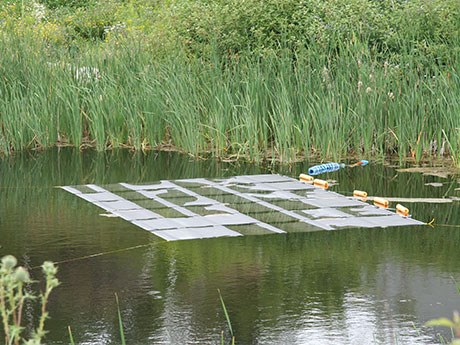More ambitious demonstration projects proposed for Canada and Israel
We’ve all seen solar panels mounted on frames in farmer’s fields and on the roofs of buildings, but Dean Millar, director of energy, renewables and carbon management research at MIRARCO – Mining Innovation in Sudbury, thinks there’s also an application for draping thin film amorphous silicon photovoltaic sheets over tailings ponds and other water bodies.
A proof-of-concept floating photovoltaic system is already installed in a pond at the Vale Living with Lakes Centre in Sudbury and a funding proposal is in the works for several more ambitious demonstrations of the technology.
Millar, who served as program director, renewable energy and senior lecturer at the University of Exeter’s Camborne School of Mines in the United Kingdom prior to joining MIRARCO in 2010, is applying to the Canada- Israel Energy Science and Technology Fund to deploy floating photovoltaic systems in tailings ponds, fish farms and other industrial water bodies in the two countries.
Floating photovoltaic systems are less expensive than land-based solar power deployments, according to Millar.
“You can buy thin film amorphous silicon photovoltaic material for under $1 per watt. The inverters that convert DC electricity to AC are around 25 cents a watt and the frame on which land-based panels are mounted are $1.50 a watt, so the frame is more expensive than the panels.”
Then there’s the engineering cost to approve a structure on a roof. That’s another $2.50 a watt, “so the fundamental price of the power conversion technology has plummeted” and it’s all these other things that are driving up the cost, said Millar.
“With floating photovoltaics, there’s no frame, and I don’t need a structural engineer. I can roll it out. That’s a saving of $4 right there.”
The thin film product is also more efficient because of the cooling effect of the water, claims Millar. Photovoltaic panels mounted on land or on the roof of a building get as hot as 50 to 60 degrees Celsius, and as the temperature rises, the conversion efficiency of the panels falls.
Floating photovoltaic sheets, by contrast, are water cooled and have an infinite heat sink backing them up. In Canada, Millar wants to demonstrate floating photovoltaics on an oil sands tailings facility in Alberta or on a Vale tailings pond in Sudbury.
In both cases, there are advantages over and above the value of the electricity produced.
In Alberta, where Syncrude Canada paid a $3 million penalty for contributing to the death of 1,600 ducks in 2008, a covering over a tailings pond could provide a barrier to birds.
In Sudbury, a floating photovoltaic cover would result in a “de-coupling of wind input across the water surface,” reducing turbulence and accelerating the settling of suspended solids. Extended up the embankments of a tailings pond, a cover would also contain dust.
Millar is proposing two potential locations for demonstration projects in Israel, including a fish farm at Ma’agan Michael, 30 kilometres south of Haifa, and an Israel Chemicals Ltd. mining operation immediately south of the Dead Sea, where potash, bromine, magnesium and chlorine are extracted from extensive lagoon impoundments.
In Israel, where water is much less abundant, a cover over fish ponds and lagoon impoundments offers the added advantage of reducing evaporation.
With demonstration projects in both countries, Millar hopes to verify “the costs and benefits of the systems in locations of varying solar resources and varying, potentially hostile water body chemistries.”
Even more ambitious applications of the technology aren’t out of the question according to Millar who has submitted a proposal to a Maltese fisheries company with a view to deploying a floating photovoltaic system over an area in the Mediterranean Sea.
Millar doesn’t expect ocean turbulence to be a problem, but that’s still to be confirmed.
“Floating photovoltaics are more competitive economically than offshore wind, which is considered to be the leading renewable energy technology today,” he claims.



